As an Amazon Associate I earn from qualifying purchases.
Fava beans are my labor’s love. I am inordinately fond of the chubby legumes, which signal to me that high spring has arrived. They are my transition between the peas of spring and the string and shelly beans that mark the summer’s heat. Here’s how to cook fava beans.
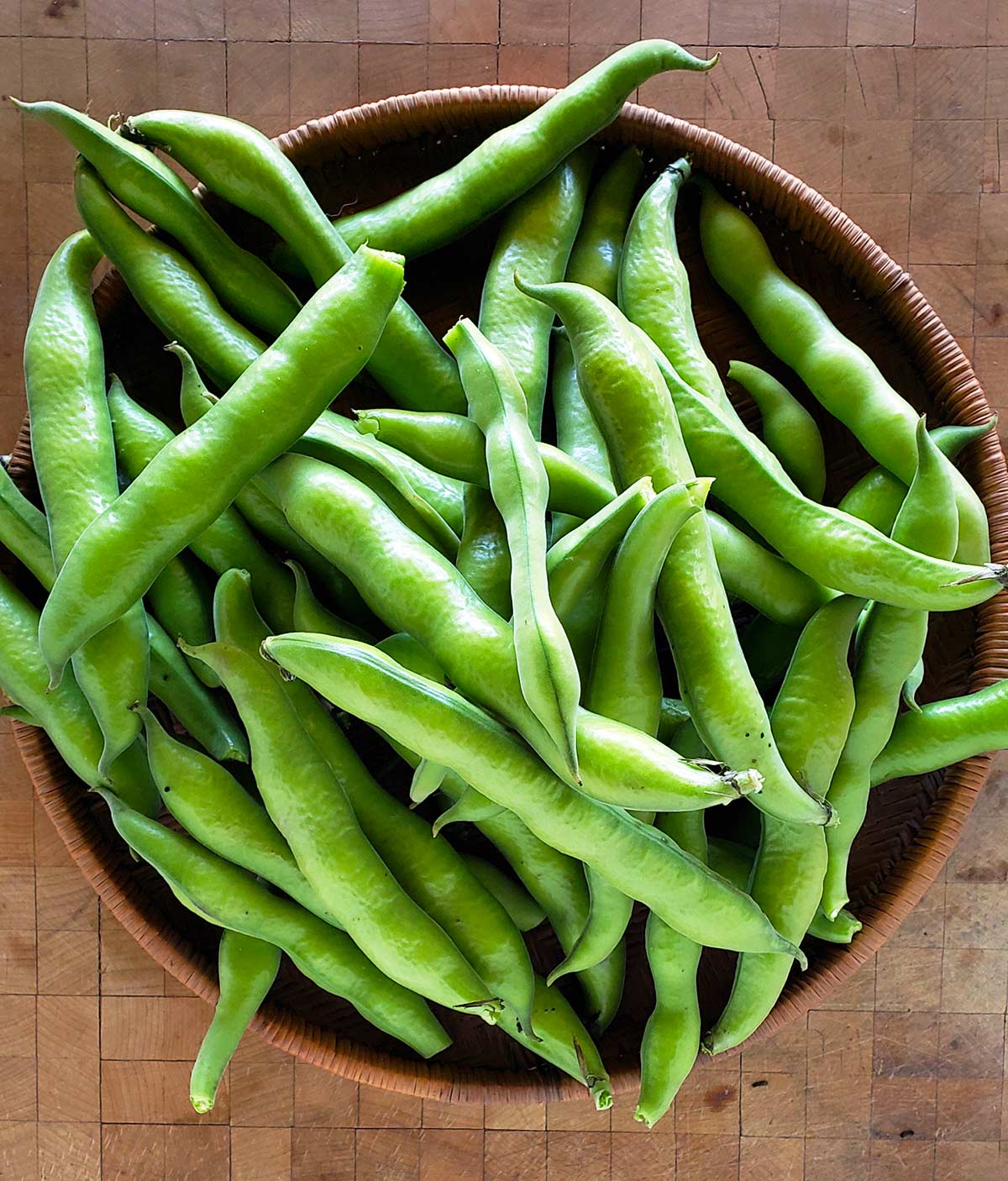
Fava beans are easy to grow, but do require lots of space and a long, cool growing season. Like my other favorite cool-weather legume the sugar snap pea, I start them in autumn and let them mature at a reasonable rate throughout the winter and spring.
By April, my fava beans have grown large. Some stand taller than six feet, a huge stalk for such a small morsel; the useful part of a fava is but a fraction of the plant. But then this is not really very different from corn or tomatoes. Or people, for that matter.
Incidentally, you can eat the young, tender tips of a fava bean plant, steamed or sautéed, they are great with butter and salt.
In case you care, here is a good primer on how to grow fava beans.
And if you fail to grow the fat Italian varieties, the useful portion of a fava bean pod will be smaller still. Unlike hot-weather beans, favas — one of the Old World’s few native legumes — do not fill their pods. I have grown varieties where the best I could hope for was one or two beans per pod.
After many flirtations with Native American varieties (adopted from those the Spaniards brought 500 years ago), English versions and even a Spanish fava, I have settled on the Italian supersimona strain, which can give me as many as eight big beans per pod. I knew I had chosen well when our Puglian neighbor Rosa looked at them and gasped, “Oh…those are better than mine!”
Yep. They are. In fact, my favas have lured me dangerously close to hubris. Other gardeners envy my favas. I have never had a bad crop. And every spring I am happily inundated with the emerald jewels. Last year I wound up with 15 pounds — after shucking. And I ate almost all of them fresh.
How to Cook Fava Beans
Fresh favas are slippery, mild, and slightly sweet with a texture not unlike al dente pasta. And they are one of the greenest things we eat. A freshly shucked and blanched fava bean is lurid — you wouldn’t think the color exists in Nature if you hadn’t grown it yourself.

But getting to that green takes effort. Many people don’t grow fava beans for just this reason. And I never fail to hear someone say, “I have no idea what to do with them!” whenever I idle near the fava bins at my local farmer’s market.
I suspect many of you who read this blog know your way around a fava bean. But for those who do not, allow me to walk you through how to cook fava beans properly.
Let’s start before the fava beans are in your kitchen. Picking fava beans takes practice: You want to pick when the favas begin to make lumps under the pods, but long before the pods discolor or begin to shrivel around the beans. You will get between 5 and 15 pods per plant.
The first shuck goes very quickly if you do it my way: Don’t bother with the strings, just anchor both thumbs behind a bean and push with them as you are bending the pod back — exactly as you would break a twig. Once you get the hang of it, you can do a bag of beans in 5 to 10 minutes. Shuck into a large bowl, as they will catapult out of the pod.

I did a short video of shelling fava beans, so you can see it in action. It’s actually vaguely fun and the pinging sound of the beans on the bowl is satisfying.
Once you have all your beans out of the pods, they will look like this:
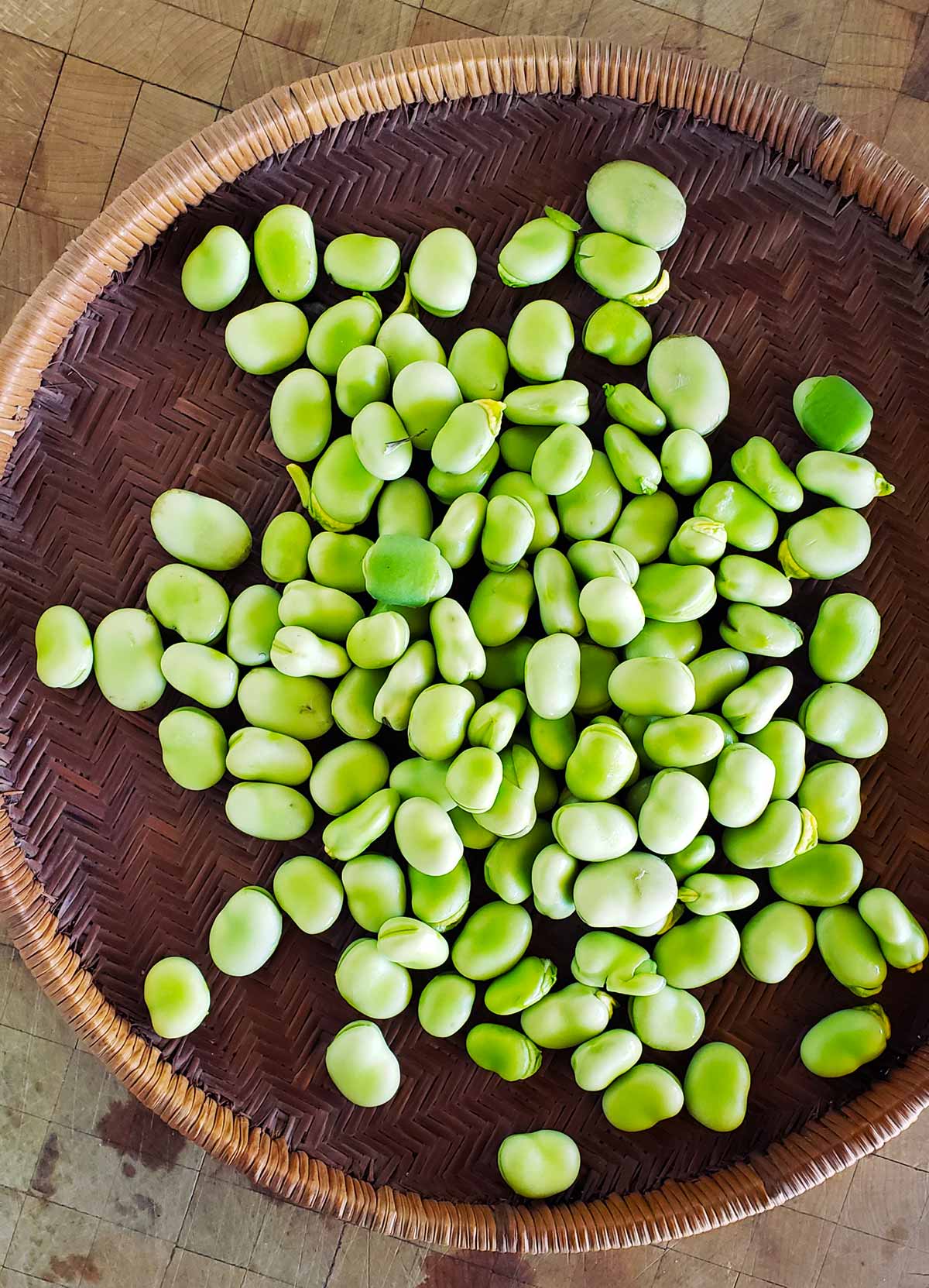
Now, there are several thoughts on what to do next.
If you have harvested fava beans very young, younger than those in the picture above, you can stop here and go right to cooking. The outer jackets are tender and digestible at this stage, and most Italians, Spaniards and Englishmen will eat them at this stage.
But if you have harvested at the stage in the pictures, those jackets are not nice to eat. So you need to undress your favas.
Bring a huge pot of salty water to a boil. How salty? It should taste like the sea. Get an ice water bath ready. Grab a couple handfuls of favas and chuck them into the boiling water. Let them boil for a minute or two. You will know they are ready when they are all floating in the top of the water and hissing at you.
Plunge them into the ice water to stop the cooking. Now look for the reverse: When all the favas have sunk to the bottom, fish them out and you can start undressing them. Some will have split jackets already: Just squeeze these out. Others you will need to prick with your thumbnail to slip out. Again, once you get the hang of it, this goes fast.
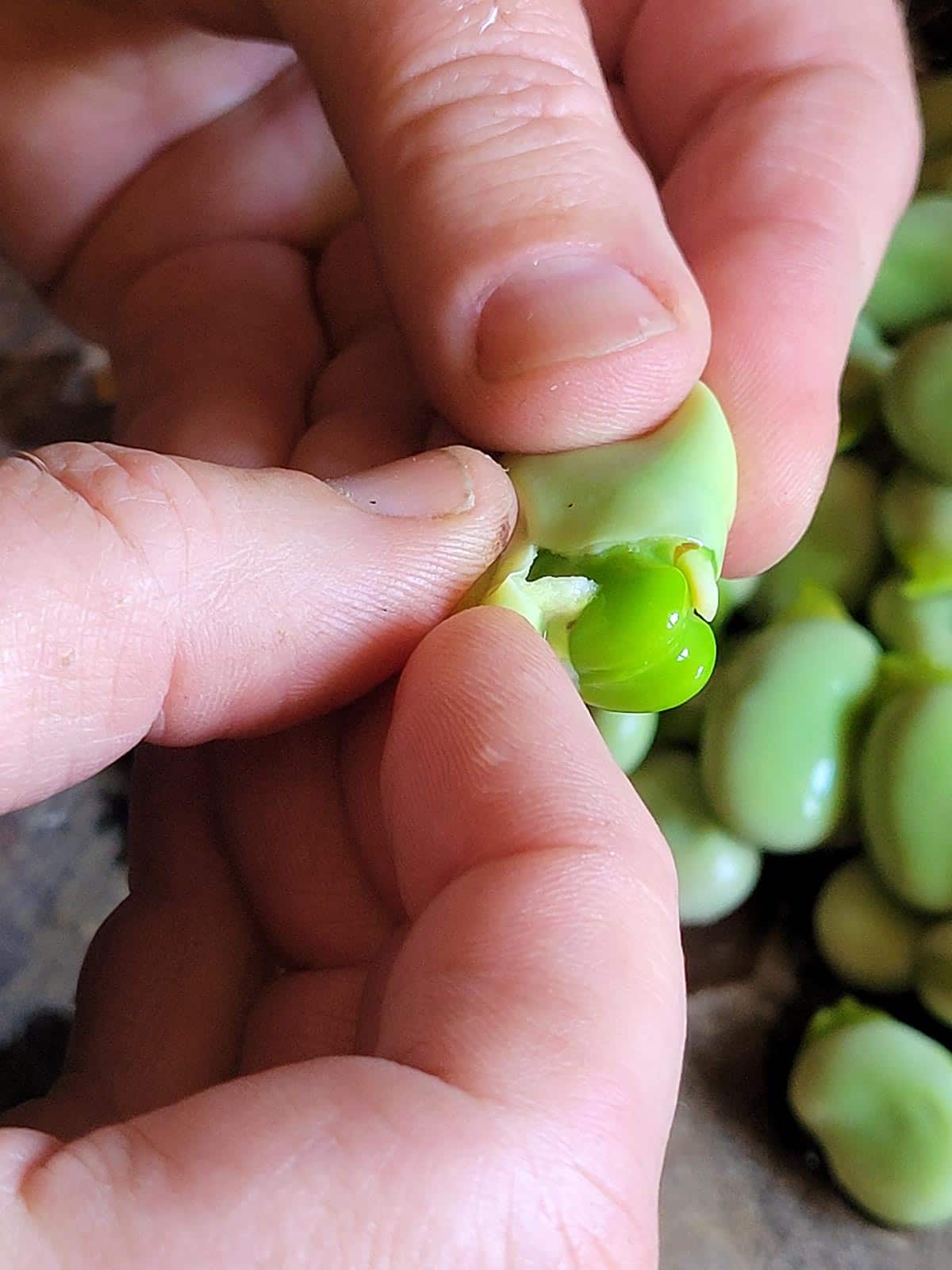
Now you can eat your fava beans, keep them in the fridge for a day or three, or vacuum-seal meal-sized portions of them and freeze for up to a year.
I have lots of fresh fava recipes, but one of my most favorite is to make a garlicky, slightly spicy puree out of them, which I then use to spread on toast. The same puree makes a fine ravioli filling, or faux pesto sauce for pasta. Another fun one is an ode to springtime I call Cheek By Jowl.
Yield is about 4:1, so 4 pounds of fresh fava beans in the pods will yield about 1 pound of shelled beans.
How to Cook Fresh Fava Beans
Ingredients
- 2 pounds fava beans in the pod
- Salt
Instructions
- Set a large pot of water to the boil. Meanwhile, pop your fava beans out of the pod. (Here is a video showing you how.)
- When the water boils, add enough salt to make it taste salty, several tablespoons. Get a bowl of ice water ready. Toss in half the fava beans and let them boil 1 to 2 minutes. Remove them with a skimmer to the ice water. Repeat with the other half of the beans.
- While the second group of beans is cooking, the first should have all fallen to the bottom of your ice water bowl. Remove them and set aside. Add the new beans and let them chill.
- Using your thumbnail, remove the outer shell of each fava bean at the top, where the yellowish scar is; on older beans this scar will be black. Discard or compost the shells. Your fava beans are ready for any number of recipes.
Notes
Nutrition
Nutrition information is automatically calculated, so should only be used as an approximation.
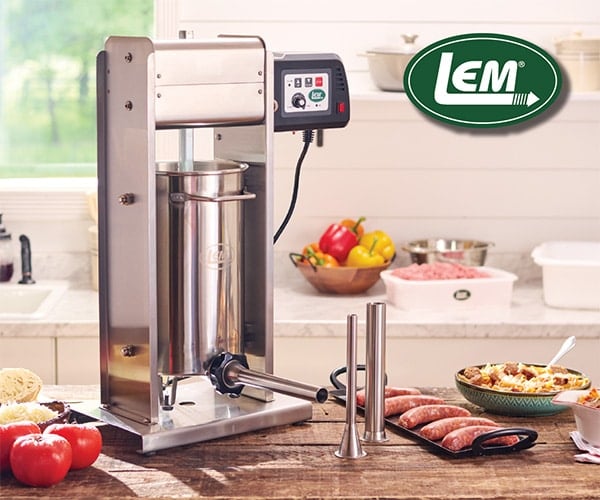
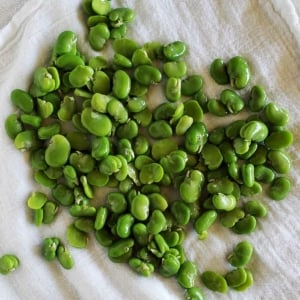

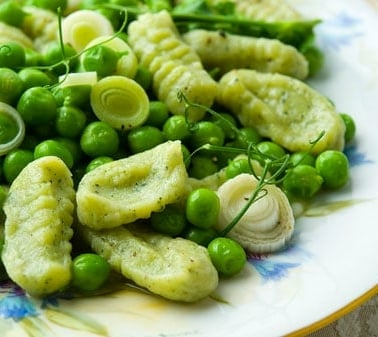
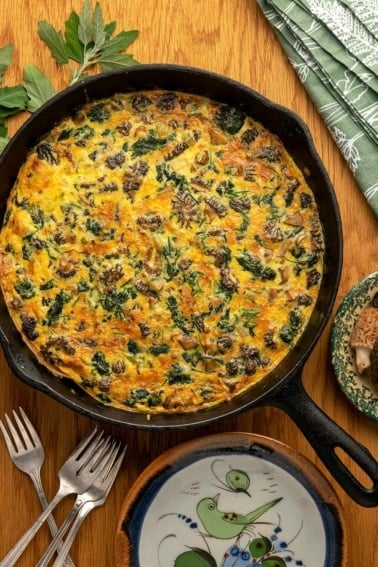
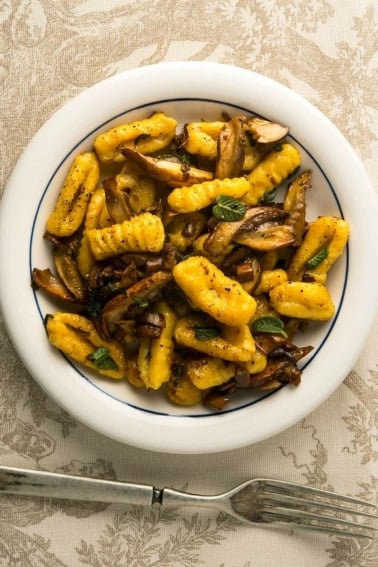
Got some Fava Beans from my CSA (Community Support Agriculture). Have never tried them before. I followed your
shelling recipe and the pods were easily removed. Love their color. One problem; I tasted one; it was delicious, a little sweetness. So I ate some more and now I dont have enough to make the recipe I was planning to make.
One thing to note: If you are watching your potassium level, they are high in potassium. I dont know if the amount in the nutritional chart is before boiling and icing. If it is before processing the beans, potassium might be lower when you boil and ice.
Thank you! Very helpful to know how to cook Fava beans. I live in Pa. Is it too late for me to plant the seeds? You mentioned bringing the Supersimons strain. Where can I buy them?
I am of Abruzzi Italian decent and grew up eating them raw with skin on them dipped in a mixture of salt, pepper and EVOL!
Lena: I don’t think it’s too late in PA. Hard to say about the exact strain now, but go over to thw website Seeds From Italy and pick one there. They have a fantastic selection.
Thank you for sharing your cooking wisdome!!
So darn helpful. Love favas – but always felt they were too tedious to handle. So I only ate them at restaurants. Your explanation showed me I’ve been doing it all wrong.
Second time in two weeks now I’ve bought and cooked favas myself. What a summer treat. Thank you!
My mind is blown, lol!! I had no idea there was a bean within a bean! Sort of like nested Russian dolls. Thank you! My question is about saving seed. I really like the beans I was able to grow. Can I save them like other beans by simply letting them dry on the vine, so I can plant them next year?
Many thanks!!
Suzanne: Yes, you can.
Thanks for the instructions. I am trying Fava beans for the first time, and at first sight I was lost. I took them out the shell, and they have been sitting in my refrigerator for a couple of days. So, stumbling on this recipe gave me encouragement. I need to cook them. I think that my fava beans are mature so I will need to take it out of the coating. Without these instructions, I might’ve just cook the whole bean.
the best energy and labor saving way to dook favas is the bbq. Pick and roast. About 10 minutes, no prep. Beans pop out of shells easily as you are eating them they squirt out the end then you can compost the shells.
That fava video cracked me up!
Cooking them up tonite, cheers!
Hank – been reading yer stuff for a while, want to take this opportunity to thank ye.
one remark – i have been living off-grid for over 20 years and always look at the energy consumption of a recipe or procedure. i fail to see the need for heating up a LARGE pot of water. interestingly, no other material on this planet takes more energy to heat one pound one degree than water, not lead, uranium etc. NOTHING!
i have been growing and cooking fava beans for a long time, and i do the first step with a SMALL quantity of salt water in a pressure cooker [i live at high altitude, at sea level the pressure cooker could be omitted though it saves a ton of energy, as well as time…].
in passing, Pasta is another dish which usually calls for insane amounts of boiling water. I asked Mark Bittman [NYTimes food writer] and he recommended a minimum of 2 qts of boiling water per pound of pasta[recipes usually call for twice as much or even more boiling water]. same for spaghetti. ye might have to stir a bit, but the TASTE is the same, at much smaller cost to the planet.
in my pressure cooker i barely cover the fava beans with salt water. do let me know if ye tried this, especially if ye think it does affect the flavor. thanks
Hello Arvo! I don’t know if you are able to receive this- it’s been awhile since your posting. I haven’t tried cooking fresh fava beans yet, but this page by Hank is inspiring and I look forward to trying it this year.
A note about the spaghetti/water issue you brought up… Kenji Lopez-Alt has a water saving technique for his spaghetti that I find very useful, and yes- you can’t tell the difference that it was cooked using so little water. He puts his spaghetti in a cold skillet and fills it with just enough water to cover the pasta. He then brings it to a boil to cook, taking maybe an extra minute or two since the water was cold to start with. Stir to prevent sticking. Not only does this work, it creates really awesome “pasta-water” to have available in your sauce.